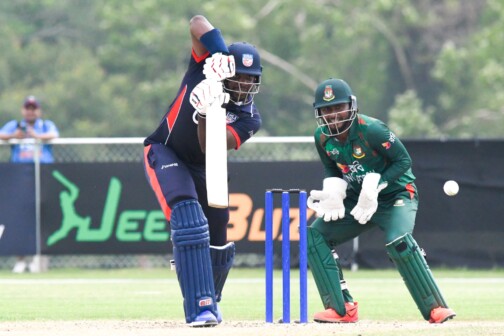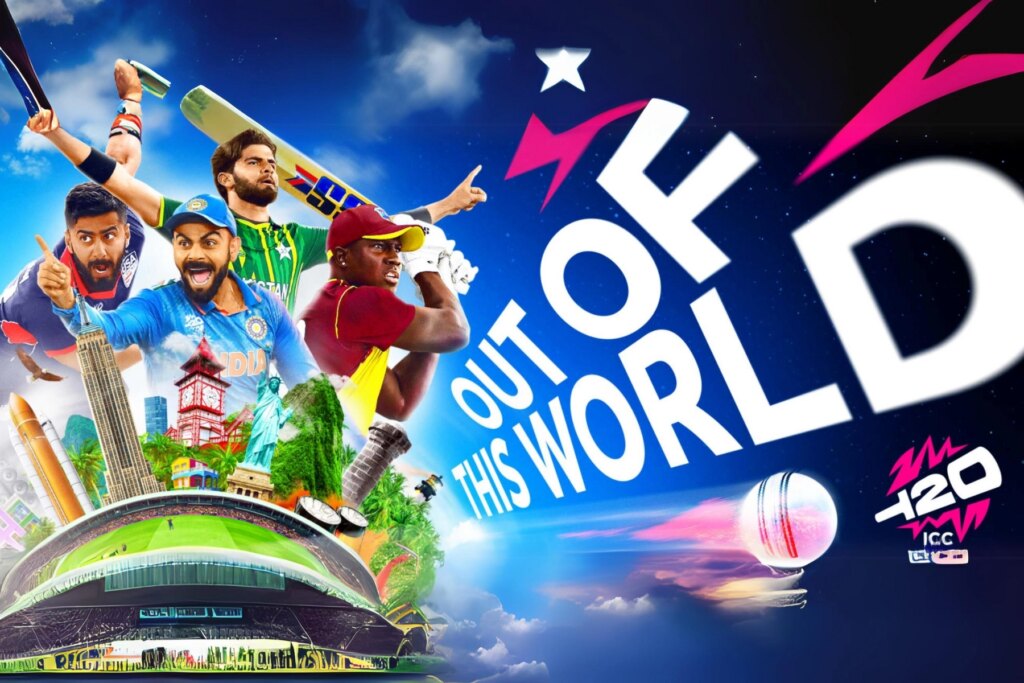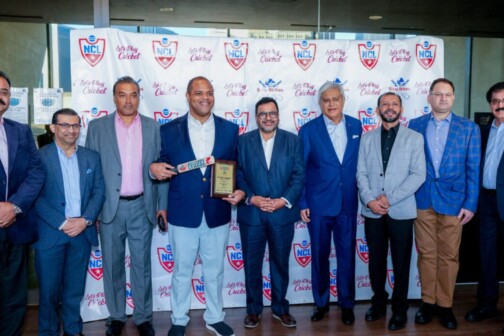It’s a Sunday afternoon in early March, and a woman is glued to her television in Fort Worth, watching her favorite batter send the ball out of the park in a masterful display of hitting. But it isn’t a Rangers game that Nazneen Akhtar is engrossed in. It’s a sport that not many Americans watch at all.
Despite growing up in Dallas, where football, basketball, and baseball reign supreme, Akhtar has become a diehard cricket fan by way of her husband, Faisal, who moved to Texas from Karachi, Pakistan, in 1986. Nazneen’s love of the sport began in 2003 when she attended an exhibition game in Dallas between squads of Indian and Pakistani Americans. She became enthralled by the passion displayed by the cricketers, so much so that she picked up a copy of Tom Smith’s Cricket Umpiring and Scoring to learn the finer points of the sport.
As her love for cricket blossomed over the next two decades, cricket’s presence in North Texas only grew. Last summer, the region became the hub for cricket in the United States when upstart Major League Cricket, the most organized attempt to give the sport a go here, chose Grand Prairie as its base of operations. Major League Cricket partnered with HKS to convert an old minor league ballpark into Grand Prairie Stadium, the most sophisticated cricket venue in the country. Nazneen attended most of the 12 games.
“I loved going to MLC games,” she says. “I met so many new people at the stadium every game. I was living the dream of seeing world-class cricketers in my backyard.”
All of that was a stepping stone for what came next. In November 2021, news broke that North Texas and the West Indies would co-host the T20 World Cup, the biggest tournament in cricket. Grand Prairie will get the ball rolling with the opening game of the competition tomorrow. The stadium will host four games over seven days.
That development fueled Nazneen’s interest in the sport. She spent most mornings in February and March watching the Pakistan Super League, considered by many as the second-biggest cricket league in the world after the Indian Premier League. Nazneen, in fact, has been consuming cricket from around the globe. Most recently, she got hooked on the Pakistani national team tour to Great Britain. She also watched last year’s longer-format World Cup in India. But it’s the prospect of watching the best players in the world in the sport’s biggest tournament that excites her most.
“In my city,” she says excitedly. “I think cricket is going to become extremely popular.”
Nazneen, who had never even heard of cricket growing up, is now a connoisseur. She is exactly the kind of fan the sport is trying to attract as it looks to build on the momentum the World Cup is expected to generate.

Nazneen’s husband, Faisal, is prominent among the immigrants from the Indian subcontinent who brought cricket to Dallas. In 1997, he co-founded the North Texas Cricket Association. More recently, he helped start the Grand Prairie Cricket Club.
“Back then, we had no grounds in Dallas, no facilities, and not many players,” he says. “I never thought that the sport was going to be this popular. I could never have imagined a time where a world-class league would be in Grand Prairie, or that the city would host the cricket World Cup.”
However, all was not well with USA Cricket prior to last year’s debut of MLC. The launch was pushed back from 2022 after USA Cricket cited a “lack of high-quality stadiums.” The governing body for cricket in the country has been embroiled in controversy for decades, owing to a lack of transparency. This resulted in the International Cricket Council handing down multiple suspensions for USA Cricket over the years. More recently, multiple court cases ranging from alleged financial misappropriation to racial discrimination have surfaced. In March 2023, a USA Cricket dispute with organizers of the MLC put the new league under threat. These crises had an impact on the sport, including on youth cricketers in Dallas.
Former Indian cricketer Thirunavukkarasu Kumaran, who runs the Texas Cricket Academy in Dallas, says the state of USA Cricket meant that few were interested in taking up the sport professionally. “Not only has cricket in Dallas been limited to those of us from South Asia or the West Indies, but players representing the U.S. aren’t even semi-professional,” Kumaran says. “Many have 9-to-5 jobs and play cricket on the side. You don’t win anything with athletes who participate in the sport as a hobby.”
Far from aspiring to help the United States win cricket hardware, most young cricketers in Dallas have been worried about making a career in the sport. Babar Arshad, one of the finest young batters in Dallas, decided against it after speaking with his seniors. “Those playing for the U.S. have told me that playing cricket professionally isn’t worth it,” he says. “There isn’t much money to be made. Cricket can only compete with other sports [in the U.S.] once it becomes a college-recognized sport.”
Because cricket is not a recognized NCAA sport, there is no incentive for kids to pursue it at a young age. Nor does it lure major sponsorships at the high school level or as a club sport in college.
One of the biggest cricketers from Dallas figured this out for herself. In 2023, months after participating in the ICC Women’s T20 World Cup qualifiers, Carrollton-born Mahika Kandanala decided to take a break from the game. “Nationally there hasn’t been too much consistency with the sport,” she says. “You see periods where there are a lot of games, and you see periods where there’s nothing at all. That kind of structure made it difficult to continue maintaining the sport. I haven’t received proper backing from USA Cricket, which made it difficult to pursue this sport at a high level.”
Kandala, 22, has decided to focus on a career as a sports psychologist.
Nevertheless, cricket in the United States was buoyed by a $120 million investment, led by Microsoft CEO Satya Nadella, which helped launch Major League Cricket in Grand Prairie. MLC teams were backed by IPL franchises and featured a glittering array of superstars. These included World Cup-winning Englishman Jason Roy, former South Africa captain Faf du Plessis, former Australian skipper Aaron Finch, New Zealand great Martin Guptill, Caribbean superstars Andre Russell and Kieron Pollard, and mainstays of international cricket such as Rashid Khan and Haris Rauf.
The MLC proved to be a resounding success, as more than 70,000 attended a tournament in Dallas and Morrisville, North Carolina, that was broadcast to 87 countries and generated $8 million in revenue. The MLC was soon followed by the launch of another Dallas-based pro cricket league. Zubin Surkari, who managed the league’s operations, says the MLC has had a transformative impact on cricket in the area over the past year.
“The presence of high-profile matches has not only drawn in existing cricket fans but also attracted new audiences who may not have previously engaged with the sport,” Surkari says. “This increased visibility has helped cricket become more mainstream in the area.”
As has a substantial investment in the infrastructure. Facilities have been upgraded, and ground has been broken on new pitches and practice facilities. “This has provided much better venues for both professional and amateur cricketers, enhancing the overall quality of the cricketing experience in the city,” says Surkari, who believes the second MLC season, scheduled for July, coupled with the World Cup, will spawn more growth and development of the game with even more investment.

The World Cup opens with the United States facing off against Canada. Among the teams Grand Prairie Cricket Stadium will host include former T20 world champions Pakistan and Sri Lanka. While the United States isn’t expected to go deep in the tournament, many in Dallas hope the World Cup gives a boost to the sport in their state and across the country, not unlike what happened with soccer after the 1994 World Cup.
“MLC has been great for American cricket,” Faisal Akhtar says. “But the World Cup is going to take the sport to the grassroots. It should encourage all Americans to take part in it. Once America as a whole embraces cricket, no one would be able to defeat us.”
Akhtar is not alone in this belief. Veteran Pakistani cricketer Yasir Hameed, who has played for the Grand Prairie Cricket Club, has been impressed with the talent he has seen during his visits to Dallas. “The young cricketers in Dallas, most of South Asian origin, have the potential to become world beaters,” Hameed says. “With proper guidelines and grassroots development, the U.S. can become a force in cricket. The World Cup will only encourage more youngsters in Dallas to take up the sport.”
Akhtar says that because the city is hosting world-class cricket, it has an identity within American cricket. “Dallas has become such a strong cricket community that people know that if [a cricketer] is coming from Dallas, they must be good,” he says.
Hameed maintains that Dallas is an ideal locale to promote the sport. “Weather is very important for cricket, since it is an outdoor game,” he says. “The sun is quite significant, not just during play, but also in the maintenance of the pitches. Dallas is in a beautiful part of the world, has all the seasons, with lovely open lands, where a lot of cricket grounds can be built to take American cricket forward.”
Houston and Dallas have the highest participation in the country. Those involved in the sport say more than 500 teams across various levels play the game in these two cities alone. However, those invested in the wellbeing and growth of the sport acknowledge that a few roadblocks remain. One of these is the lack of cricket at the grassroots level.
“That requires a comprehensive approach that focuses on youth engagement, community involvement, infrastructure development, and strategic partnerships,” Surkari says. “Integrating cricket into school sports programs is crucial. Hosting cricket clinics, workshops, and recreational leagues in community centers and local parks can make cricket more accessible.”
He adds that the league aims to build more cricket facilities in neighborhoods, establish more grassroots cricket clubs and leagues, and enhance coaching standards by training professionals and engaging international cricketers. The hope is that demographics beyond South Asian and Caribbean immigrants take up the game.
“All of this requires good leadership and strategy coupled with a dynamic workforce,” Surkari says.
Cricketers of South Asian descent in Dallas believe that other communities will take up cricket now that the game is becoming a part of the sporting culture in Texas. They say that playing cricket has helped them embrace their Texan and American identities. When these cricketers see the seal of Dallas or the flags of Texas or the United States on their jerseys, they feel a sense of pride.
“Whenever I get to play for the U.S., I always treasure that,” Kandanala says. “I do factor in my heritage and I do want to be in touch with it always, but for me, I am never an Indian person playing for the United States. I am an American playing for the United States. And the Texan identity definitely plays a role. Being Texan has its own sense of identity and values.”
Professionals involved in cricket in Dallas insist that expanding the demographics will make the sport more competitive. “You need more White Americans to play cricket, for which you need more White people to come and watch the World Cup,” Akhtar says. “That would increase the interest and bring more money.”
The next opportunity starts Saturday in Grand Prairie. The world will be watching.





